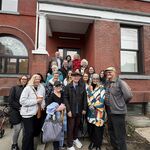Streety McCarface
Senior Member
Bombardier has had its sh!t together for a while. Grandlinq had this equipment spec'd since 2014. The Region of Waterloo however delayed the signing of this second contract until the last possible second for God only knows what reason.
CN Waterloo Spur.
Wasn't possible or practical given GRT's plans for buses.
Speeds are only limited in the high traffic area that is the UW campus or on approach to stations.
Blame UW for this. They were being stubborn over what buses they would allow on Ring Road.
That one vehicle that (allegedly) had wheel flats is being used to debug the software integrations of the new specialized equipment and those sorts of issues were expected. That specialized equipment BTW is used to apply the emergency brakes if the operator:
- Doesn't acknowledge a change in signal state
- Doesn't acknowledge the transition from LOS to ATP
- Doesn't apply Full Service brakes in time to stop at a non-permissive signal.
- Attempts to drive through a non-permissive signal without a CCF clearance.
A stop at McCormick would have been too close to both R&T and Northfield and would have reduced average speed through the Waterloo Spur segment significantly. It would also have had significant impact to the Laurel Creek. The lack of heaters won't make much of an impact to ridership when peak service is for 8 minutes at the start and scaling down to 5 minute minimum in the future.
Bombardier has not had its sh!t together, they're still having streetcar delays with the TTC and all our vehicles still haven't been delivered, and likely won't be delivered by the end of December. Grandlinq and the ROW share some blame as well, but to imply bombardier actually has their sh!t together is ludicrous.
GRT's plan has a bunch of bus routes (19B, 73, 9) terminating or serving there when the LRT starts running. The very least they could have done was expanded the facilities at Conestoga mall as well.
I do blame UW, but the fact that this wasn't addressed earlier is a huge problem. It's also a little ridiculous that they're not considering rerouting buses down segram and Albert.
arcGIS is showing that the McCormick stop would have been 1 km from the Northfield stop, and 900 meters from the R & T park stop. Given that more people get on and off at McCormick than both other stops combined on the 200, I'd say it should have been a priority from the get go. To put things in perspective: UW and Waterloo Park stations are 600 meters apart, the uptown stations are between 500 and 600 m, the the Allen and GRH stations are 600 m apart. The average stop distance for the LRT is about 1 km, having a McCormick stop is perfectly fair, especially since trains can bypass Northfield and RT park if no one is on the platform there.




